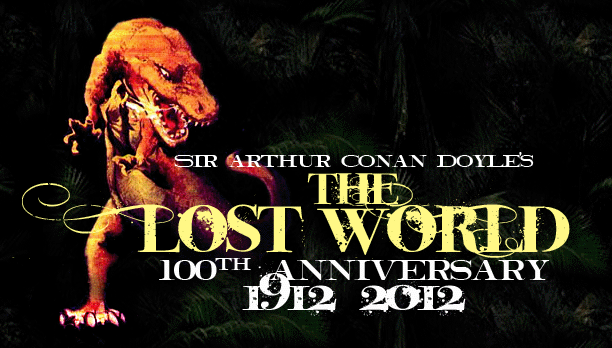|
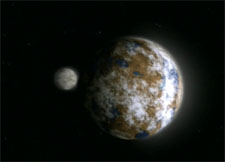
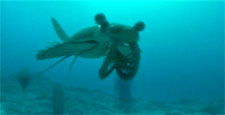
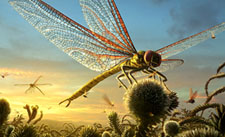
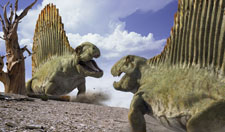
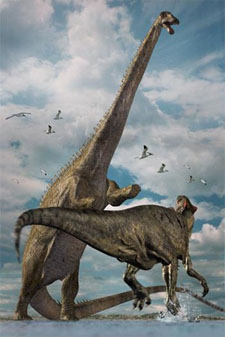
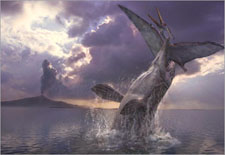
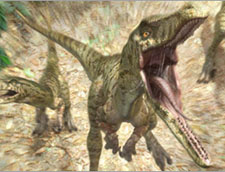
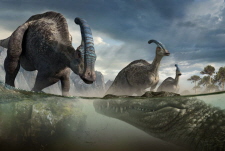
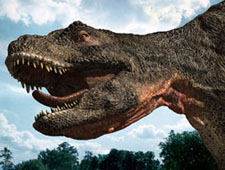
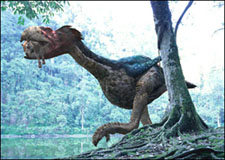
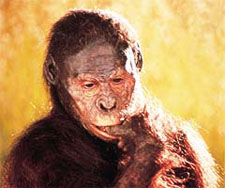
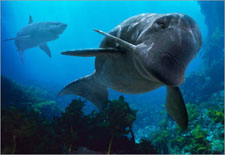
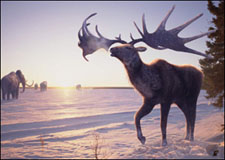
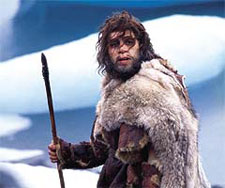
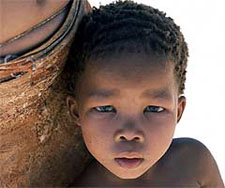
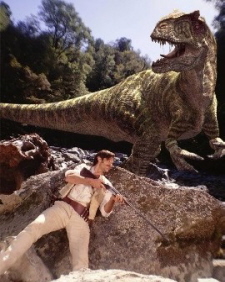
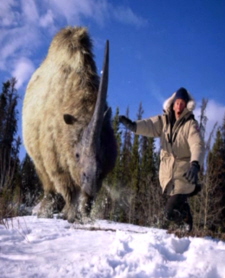
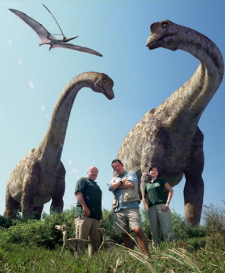
Walking With Dinosaurs Links
- BBC Online: Science & Nature: Prehistoric Life.
- Official page for the "Walking With" franchise.
|
In the wake of the Jurassic Park series redefining the genre of saurian cinema, producers Christopher Hall and Tim Haines along with the British Broadcasting Company asked a deceptively simple question: could what Jurassic Park did for dinosaur movies be applied to dinosaur documentaries? What if, through advanced computer generated imagery and mechanical prosthetics, we could envision a wildlife documentary shot in the midst of the Mesozoic? In answering that question, they created a documentary franchise with unparalleled scope, spanning from the very beginning of the planet earth to the evolution of human beings to Science Fiction edutainment and Edwardian flights of fancy.
- Walking With Dinosaurs by Tim Haines and Jasper James (Dirs.), BBC (1999)
- The franchise began in 1999 with the 6-part Walking With Dinosaurs. Taking generally meticulous care to stay palaeontologically reasonable and palaeoecologically accurate, each of the 6 episodes descends the viewer into different regions of the earth at different times through the age of dinosaurs, focusing on a well-known species of fossil locality.
The series begins in the Late Triassic of Arizona with New Blood, focusing on large archosaurs like Postosuchus and newly emerging dinosaurs like Coelophysis. The following episode, Time of the Titans, looks at the Late Jurassic megafauna of Colorado: Diplodocus, Allosaurus, Brachiosaurus and Stegosaurus. Cruel Sea explores the Late Jurassic oceans of Oxfordshire. The global migration of the giant Early Cretaceous pterosaur Ornithocheirus is followed in Giant of the Skies. The pentultimate episode, Spirits of the Ice Forest, examines the Middle Cretaceous world of Australia’s Leaellynasaura and Muttaburrasaurus. The final episode, Death of a Dynasty, goes to Late Cretaceous Montana to look into the life of Tyrannosaurus just before (and as) a climactic meteor impact wiped out non-Avian dinosaurs forever.
The series is not without its flaws… Some are purely technical flaws in integrating CGI with the surrounding filmed environment. Others are palaeontological, which is understandable given the daunting task of trying to create a dinosaur wildlife documentary from fossil materials. But regardless, the series is still highly informative and entertaining. One is still given the very dramatic sense of peering into the deep past to view the closest thing to living palaeontological specimens that we’re likely ever to see. Its worst faults are still nowhere near the cinematic obscenities of Jurassic Park, while still being fascinating enough just as the high drama of nature red in tooth and claw (and sometimes it’s pretty red). Though almost 10 years old, Walking With Dinosaurs will still be the definitive dinosaur documentary for years to come.
- Allosaurus: A Walking With Dinosaurs Special by Kate Bartlett and Michael Olmert (Dirs.), BBC (2001)
- Following up the original Walking in Dinosaurs was this one-off special episode revisiting the Late Jurassic of Wyoming to trace the life of a unique fossil specimen of Allosaurus nicknamed “Big Al”. What made this nearly complete, juvenile Allosaur find so unique was that he was practically covered in bones broken or infected in life. One of these, an infected middle toe, is likely to have incapacitated Big Al so badly that it ultimately cost him his life.
- Walking With Prehistoric Beasts by Nigel Paterson (Dir.), BBC (2001)
- Following the formula of Walking With Dinosaurs and picking up where that series left off, Walking With Prehistoric Beasts explores the Cenozoic Era, from the death of the dinosaurs to the evolution of Homo sapiens.
New Dawn, the first episode, picks up right with the impact of the meteor that spelled doom for the dinosaurs and explores the environment of Early Eocene Germany, with the continued persistence of small mammals against the evolution of the first large, flightless, “terror birds”. Whale Killer moves to the Late Eocene Tethys Ocean of what would become Egypt and Pakistanto follow Basilosaurus. The early life cycle of the gigantic Indricotherium – largest land mammal ever – of Late Oligocene Mongolia is traced in Land of Giants. Human evolution is explored for the first time in Next of Kin, which examines our earliest ancestor: the Australopithecus of Pliocene Ethiopia. Sabre-Tooth, unsurprisingly, takes the viewer to Early Pleistocene Paraguay and into the world of the mighty Smilodon, Megatherium and Phorusrhacos. The last episode of this series, Mammoth Journey, goes to the iconic Ice Age of Late Pleistocene Europe to follow the winter migration of a herd of Mammoths and their encounters with early humans and Neandertals.
This series carries many of the same benefits and faults of Walking With Dinosaurs, but also adds one of its own. For some reason, the producers felt it necessary to emphasize the everpresent threat of extinction for the ecosystems being presented, which leads Shakespearian narrator Kenneth Brannagh to frequently – even comedically – sound dreadfully ominous about a coming carbon dioxide apocalypse in New Dawn, the closing of the Tethys in Whale Killer, and even the eventual extinction of us at the end of the series. Nevertheless, it is still as highly watchable and educational as the first.
- The Lost World by Stuart Orme (Dir.), BBC (2001)
- This mini-series, of course, garners a larger review elsewhere. However, it is worth noting here that while it does stand on its own as a reasonably accurate adaptation of the novel (with some very pointed divergences), BBC’s The Lost World achieves its full effect as a part of the wider Walking With Dinosaurs franchise. Nearly all of the dinosaur effects are pulled right out of effects company Framestore’s databases, and an enjoyable afternoon could be spent watching the entire franchise, from chronological beginning with 2005’s Walking With Monsters to chronological end with 2001’s The Lost World and 2006’s Prehistoric Park.
- Chased by Dinosaurs by Tim Haines and Jasper James (Dirs.), BBC (2003)
- Taking a slightly different approach than the previous Walking With Dinosaurs specials, the two episodes that comprise Chased by Dinosaurs emphasize the “ancient wildlife documentary” approach by having actual wildlife documentarian Nigel Marven interact with the creatures on camera. Bringing his experience with genuine wild animals to the series, Marven does an admirable job convincing us of his being actually present in the prehistoric past. Of course, the flaw is that we don’t actually need Marven to tell us how amazing these dinosaurs are: the very premise of the Walking With Dinosaurs franchise is to enable us to see it for ourselves. But the episodes are scripted in such a way that Marven unfolds a palaeontological mystery on behalf of the audience, acting mostly as a plot device.
This series is comprised of the episode Land of Giants, in which Marven risks Giganotosaurus and Sarcosuchus attacks in Middle Cretaceous Argentina to weigh the massive Argentinosaurus, and Giant Claw, in which Marven tracks down Therizinosaurus amidst Velociraptors and Protoceratops.
- Sea Monsters: A Walking With Dinosaurs Trilogy by Jasper James (Dir.), BBC (2003)
- Continuing the trend begun with Chased by Dinosaurs, Sea Monsters has Marven and the crew of his ship, the Ancient Mariner, explore the “7 Deadliest Oceans of All Time”. This series is high on cinematic drama, ending each of the three episodes on a cliffhanger that puts Marven in some kind of mortal danger. It is quite effective though, and makes for some gripping edutainment.
The seven deadliest oceans, in reverse order are: the Ordovician with sea scorpions and orthocones; the Triassic of Switzerland, with Nothosaurus and Cymbospondylus; the Devonian reefs of Ohio, governed by Dunkleosteus; a return to the Eocene ocean of Egypt to track Basilosaurus; the Pliocene of Peru with the giant Megalodon shark; another return to the Jurassic of England with its Liopleuridons (featured in episode 3 of Walking With Dinosaurs); and the most dangerous, the Late Cretaceous inland sea of North America.
- Walking With Cavemen by Richard Dale (Dir.), BBC (2003)
- Continuing the original trend of the franchise, Walking With Cavemen essentially picks up with the fourth episode of Walking with Prehistoric Beasts and ends with the sixth. Inbetween, it explores the evolution and diversification of human beings and our ancestors. But also picking up on the trend of Chased by Dinosaurs, this voyage through four million years of evolution is hosted by the jovial-looking Robert Winston, a medical scientist, professor, English baron and BBC documentarian. And while there is still much CGI employed for large animals, the titular cavemen are portrayed by people in costumes and prosthetics, adding a necessary element of humanity that was missing from the Walking With Prehistoric Beasts episode on Australopithecus. This addition of intangible human expression was entirely necessary for what the series ultimately amounted to: more than just a wildlife documentary of ancient humans, it is as much a celebration of humanity and how we became who we are.
The course of the series begins with the famous “Lucy” specimen of Australopithecus. The second episode looks at the contemporaneous Paranthropus boisei, Homo habilis and Homo rudolfensis. The third follows the outward migrations of Homo ergaster and Homo erectus, including the development of language. The fourth looks to the Homo heidelbergensis and Homo neanderthalensis of Europe and the evolution of Homo sapiens in Africa.
- Walking With Monsters: Life Before Dinosaurs by Tim Haines and Chloe Leland (Dirs.), BBC (2005)
- So far, this is the last installment of the “Trilogy of Life”, bookending Walking With Dinosaurs on the opposite side of Walking With Prehistoric Beasts. Walking With Monsters returns to the form of the pure wildlife documentary, starting with the formation of the earth through the beginning of the reign of dinosaurs. The only substantive difference is that segments are interspersed with a “fast forwarded” looks at how one later species evolved from another (and almost invariably picking the wrong evolutionary lineages) and occasionally the segments themselves pause to give a “living x-ray” of some feature of a prehistoric creature, like a heart or a vertical hip socket.
Episode one, as mentioned, begins with the formation of the earth by giant impact with a stellar body named Theia. Then it traces through the Cambrian explosion of multicellular life in China, the evolution of boney fishes and sea scorpions in Silurian England and ends with the evolution of amphibians in Devonian Pennsylvania. Episode two goes from the giant insect fauna and evolution of reptiles in Carboniferous Kansas to the sailbacked reptiles of Early Permian Germany. The last episode begins with the mammal-like reptiles of Late Permian Siberia’s Pangean desert, crosses over the Permian-Triassic extinction event, and looks at the earliest ancestors of dinosaurs, mammals and crocodiles in Early Triassic Antarctica.
Inventively, the series builds up ancient history as a conflict for domination between arthropods and vertebrates, beginning all the way back with Anomalocaris and Haikouichthys and finally conquered by the development of large reptiles… Only to be transferred, then, to reptiles vs. mammals.
Unfortunately, the biggest problem with Walking With Monsters is its length. At 3 half-hour episodes, it runs half the length of the previous two “Trilogy of Life” segments and must cram in all evolution from 4.5 billion years ago to 225 million years ago. In part, this was due to the fact that there isn’t a lot to grab onto emotionally with faceless hordes of insects and amphibians, but that is honestly a very poor excuse. Were the will and the finances there, Walking With Monsters could have easily filled out a full 6 episodes and included any of the fascinating areas of the Palaeozoic – like the Pre-Cambrian and Cambrian explosions of life, Devonian reef systems, and so on – that were left out due to length. But for what there is, it’s a grand conclusion to the proper “Trilogy”.
- Prehistoric Park by Matthew Thompson, Sid Bennett and Karen Kelly (Dirs.), BBC (2006)
- Nigel Marven returns in a series that goes even deeper into the edutainment field and comes up, often, as Science Fiction. Marven is traveling through time in the hopes of stocking his new zoo, Prehistoric Park. Framestore’s vast catalogue of palaeontological creatures from 8 years of Walking With Dinosaurs specials come out to join him (along with several new ones), and the life and behaviours of ancient animals are creatively explored by putting them in this hypothetical situation. How would a Mammoth interact with a group of modern elephants, and what would it do when facing off with a T-rex? How would one go about capturing a saber-toothed cat or facing down a monsterous Deinosuchus? These and more questions are explored in this series.
In the first episode, T-rex Returns, Marven rescues a Triceratops, a herd of Ornithomimus and two baby T-rexs from Late Cretaceous Montana with only minutes to spare before the meteor impact wave reaches them. In A Mammoth Undertaking, a Mammoth and Woolly Rhinoceros are brought back from Late Pleistocene Siberia. Journeying back to mid-Cretaceous China, Dino Birds sees Marven attempting to rescue feathered dinosaur specimens from a volcanic eruption. The fourth episode, Saving a Sabretooth, pretty much speaks for itself. In The Bug House, they recover several species of giant insects from Carboniferous Scotland. In the final episode, Supercroc, a Deinosuchus is rescued from Late Cretaceous Texas as all Hell breaks loose back at the zoo. A proper serial, animals recovered in each episode figure in later ones as the keepers figure out how to handle them, up to the final episode when a Titanosaur stampede breaks open the T-rex cage, forcing a standoff between T-rex and a Mammoth.
Review by Cory Gross. Images courtesy of the BBC, on whose site they were formerly available as desktop wallpapers.
|
